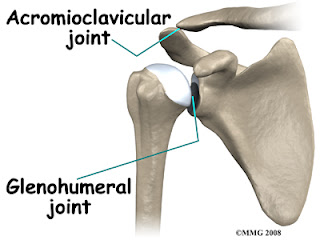What is the anatomy of acromioclavicular (AC) joint?
The shoulder complex is made up of three bones, which are connected by muscles, ligaments, and tendons. The large bone in the upper arm is called the humerus. The shoulder blade is called the scapula and the collarbone is called the clavicle.
The acromioclavicular joint of the shoulder complex is where the outer (lateral) part of the clavicle is joined to a projection on the top of the scapula known as the acromion process. The joint connecting these two bones is known as the acromioclavicular (AC) joint. The AC joint allows a small amount of movement to occur between clavicle and the acromion process.
Ligaments are like strong ropes that help connect bones and provide stability to joints. In the AC joint there are three main ligaments. The acromioclavicular ligament connects the acromion process and the clavicle. The coracoclavicular ligaments (the trapezoid ligament and conoid ligament) connect the clavicle with another projection of the scapula called the corocoid process.
What is osteolysis of the distal clavicle?
The word “osteolysis” refers to a softening, absorption, and dissolution of bone or the removal or loss of calcium in bone. At the acromioclavicular joint the end of the clavicle can undergo osteolysis. Over time osteolysis of the end of the clavicle can result in the loss of 0.5 to 3 cm of bone.
What can cause AC joint osteolysis?
No one knows for sure what causes osteolysis of the distal clavicle but some risk factors include:
– A single injury to the AC joint or to the end of the clavicle
– Repetitive minor injuries to the AC joint or to the end of the clavicle
– Repetitive heavy weight lifting such as overhead shoulder press and bench press
– Pre-existing disease states such as rheumatoid arthritis, hyperparathyroidism, infection, multiple myeloma, and scleroderma.
– Repetitive minor injuries to the AC joint or to the end of the clavicle
– Repetitive heavy weight lifting such as overhead shoulder press and bench press
– Pre-existing disease states such as rheumatoid arthritis, hyperparathyroidism, infection, multiple myeloma, and scleroderma.
What does osteolysis of the distal clavicle feel like?
Osteolysis of the distal clavicle usually comes on slowly and results in shoulder pain, stiffness and/or swelling. The pain may is felt in the area of the AC joint or the end of the clavicle. The pain is usually made worse by activities such as bench press, shoulder press, push – ups and throwing.
This swelling of the AC joint can also result in pressure on the rotator cuff beneath and, as a result, can cause pain fro the shoulder rotator cuff tendons. This is called impingement or tendinitis.
Can osteolysis of the distal clavicle be detected on X-rays?
X-rays can be an effective tool for identifying osteolysis of the distal clavicle but the bony changes may take weeks or months before they can be seen on an X-ray. A bone scan is an effective tool to help identify early osteolysis. A bone scan will show increased uptake over the distal clavicle and, occasionally, increased uptake in the acromion process. Magnetic resonance imaging exhibits altered signal intensity in the distal clavicle but is not necessary to make a definitive diagnosis.
What is the treatment for osteolysis of the distal clavicle?
The goal of treatment of osteolysis of the distal clavicle is to reduce pain while the clavicle “remineralizes”. Rest or activity modification, anti-inflammatory medications and ice are usually prescribed to reduce pain. If these measures are not effective an injection of cortisone into the AC joint may be necessary. In most cases, the clavicle slowly remineralizes (over 4 to 6 months), but may take on a tapered appearance. If you are not better after 4-6 months of treatment or observation, it is less likely that you will improve without surgery.
In some cases, the bones do not remineralize and surgery may be required. The surgeon may consider resecting (removing) part of the affected clavicle to reduce symptoms. This can be done arthroscopically and involves burring back the end of the clavicle.
The results of surgery are generally excellent with an eventual resolution of all of the shoulder pain from the AC joint.
Click here for an animated version of the distal clavicle resection.
Can osteolysis of the distal clavicle be prevented?
When symptoms of AC joint pain first develop, avoiding pain provoking activities is recommended. Additional padding for contact sports can also be effective. Finally, weight lifters should avoid locking their elbows during the bench press, use a narrower grip on the bar, and avoid bending their elbows past horizontal.
Click here for a patient’s guide to osteolysis of the distal clavicle.
Thanks,
JTM, MD


